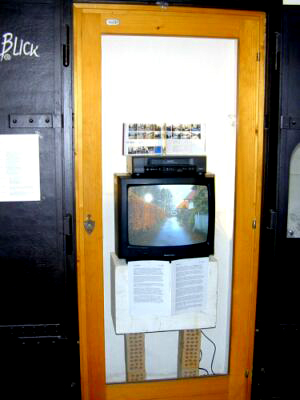 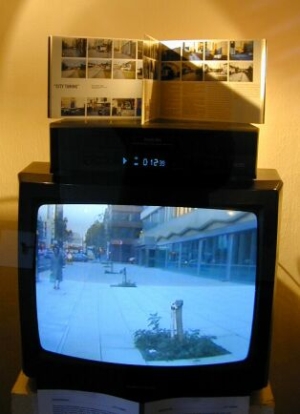 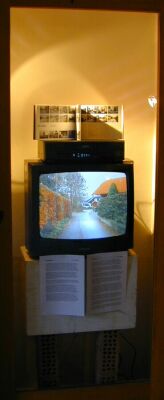 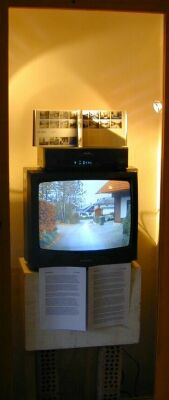 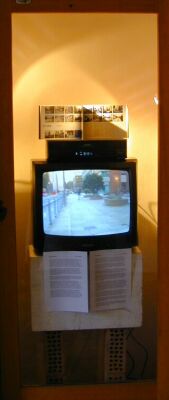 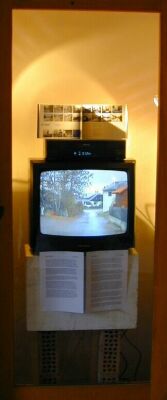 |
Florian Knopp EinBlick sagt mehr als 1000 Worte, März 2002 Titel: "CITY TUNING" Technik: Videofilm, 60 min. Buch Beschreibung: (deutsch und englisch) Am Anfang meines Projektes stand die Überlegung was für Auswirkungen die Aufwertung durch die Eröffnung der Tate Modern im Stadtteil Southwark mit sich bringen kann. Die Lebensqualität in einer Stadt hängt nicht zuletzt mit den Strukturen bzw. Angeboten und den sich daraus ergebenden Möglichkeiten zusammen. Unter Voraussetzungen die ein Bewohner haben kann, verstehe ich Gebäude die für die Öffentlichkeit zugänglich sind, wie Krankeneinrichtungen, Postämter, Schulen und Universitäten, Lebensmittelmärkte, Verkehrsverbindungen und nicht zuletzt auch Museen und Galerien, um nur einige Beispiele zu nennen. Derartige Einrichtungen tragen zum Lebensstandard bei. Bei der Frage nach Qualität müssen aber auch noch andere Faktoren berücksichtigt werden. Ein in meinen Augen ganz wesentlicher Faktor ist die Entwicklung einer Stadt und demzufolge die Fragen: "Wer investiert und warum?". Also, woher kommt das Geld mit dem ganze Stadtteile verändert werden können, und was bedeutet dies für die Bewohner solcher Stadtteile, die ganz offensichtlich davon mehr oder weniger beeinflusst werden. Nachdem die Tate Modern in Southwark eröffnet wurde hat sich das öffentliche Interesse auf das ehemalige Industrieviertel gerichtet. Durch den Besucherzustrom können auch viele andere Institutionen profitieren, durchaus denkbar ist es auch das dieses Gebiet vom Tourismus überlaufen wird. Mit meiner Arbeit verweise ich auf individuelle Erkennungsmerkmale im öffentlichen Raum und biete verschiedene Möglichkeiten der Betrachtung. Das Video, nimmt den Betrachter mit auf eine Reise durch ein Gebiet in dem Orientierung nur schwer möglich ist. Der Blick den die Videokamera ermöglicht, wechselt ständig von den Straßen in Southwark zu den Wegen aus meiner Kindheit, die ich unter anderem auch in Ohlsdorf verbracht habe. Persönliche Erinnerungen vermischen sich im Video mit den Eindrücken aus Southwark. Mein Hintergrund in Relation zur gegenwärtigen Situation rund um die Tate Modern. In den zum Video abgespielten Interviews sind
Bewohner von Southwark und Ohlsdorf zu hören, die mir den Weg erklären.
Hierbei geht es mir um die Unterschiede, wie und woran sich Bewohner
einer Stadt und die eines Dorfes orientieren. Die Interviews dienen auch
als zusätzliche Hinweise zu dem Video. Hinweise, die einen auf andere
Zusammenhänge bringen können und sich nicht direkt auf das Video
beziehen. Damit soll das Herumirren in dem Stadt- Dorfgebiet noch
verdeutlicht werden. Das Dorf, in dessen Zentrum die Kirche steht, nimmt
Bezug zur Stadt, in der überall Schilder den Weg zur Tate Modern weisen.
All these influence, the possibilities you may have and consequently the value and quality of life. In reference to the quality, we have to consider the process of development. On the one hand "Who is it to decide the value of quality?", "Where does the money come from?" and on the other hand, "What does this mean to the people who actually live there?". The Tate foundation has been interested in the Southwark area. Obviously the availability of the former Power Station building, which is now used as a museum, was one reason. Many other institutions can participate in the revaluation of the particular site. In Southwark the inhabitants can probably also profit from the changes. My video installation shows a mixture between images of a tourist tour through Southwark, mainly the guided way from the new underground station to the TATE MODERN and streets I used to go in a small village where I grew up. (Ohlsdorf near Gmunden in upper Austria) I connect the impressions I got in Southwark with the memories I have from Ohlsdorf. My personal environment from my childhood in comparison to Southwark. The main difference are the church which is in the centre of Ohlsdorf and the Tate Modern which is in the centre of Southwark. The images of this two buildings have visually a lot in common. For example the towers, which are for me like the observers watching the area around them. Furthermore there is a relation between religion and art, in Southwark the architecture speaks for itself. When I came for the first time to the Tate Modern I had the felling I´ m visiting a huge cathedral. The entrance hall is really massive and the people seemed to disappear. This new museum was not build to create a new idea of a museum it is thought to represent London as the "city number one" for modern art. With my video I like to play with different images and the idea of finding or loosing orientation. I find it interesting how people describe their surrounding, because I think where you come from is more or less what you see, at least it influences you. It depends if you are from Ohlsdorf or Southwark how you look at the video. People who know Ohlsdorf will expect different thinks as people who know Southwark. Within the video you walk apparently endless ways through a "no name area", without a final destination. Expectations along the way will be permanently deconstructed. Every time you turn left or right you change from the one area to the other, from the village to the city and back again. The Installation also includes sound and
interviews with people from Southwark and Ohlsdorf. The questions in the
interview are about the orientation in their respective surrounding. At
the end you have many links between the two areas and it depends on your
background which one you get. |